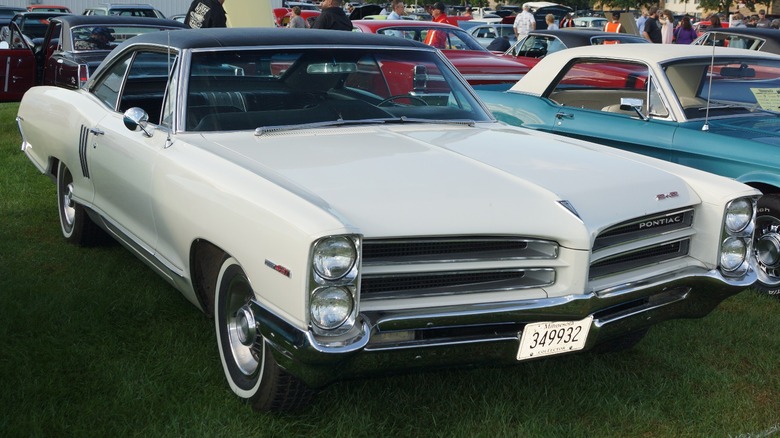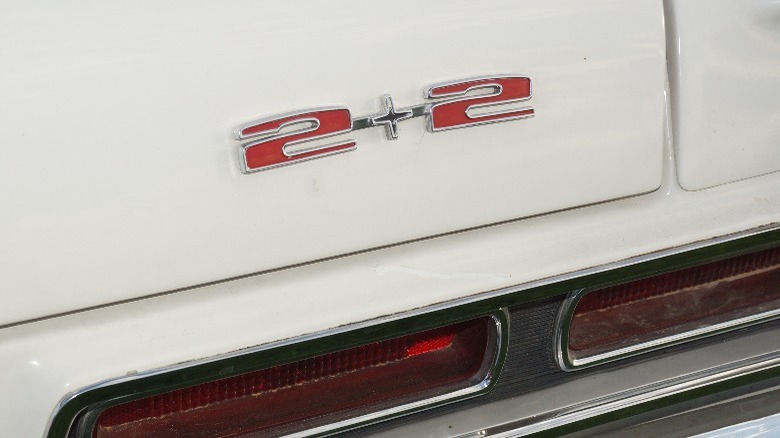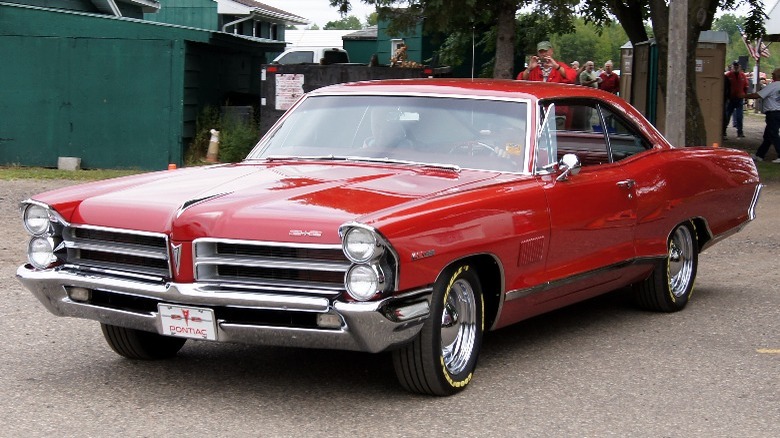What Is A Pontiac 2+2 And Which Years Was It Made?
In 1964, as Ford launched its sporty Mustang and Porsche launched its 911, automakers everywhere were bitten by the performance bug. Pontiac caught the fever, unveiling its midsize GTO, then adding sport appeal to its full-size lineup with a "2+2" edition of its successful Catalina coupe and convertible. Ferrari inspired both the GTO and 2+2 names for Pontiac. In Ferrari's coupe, the "+2" meant there was room in the back for two more passengers. Pontiac's 2+2 actually sat five, since it was a full-size car on the B-body frame.
The wide-track, rear-wheel drive Catalina was a two-door sports sedan designed to be a fun drive. For a fistful of dollars (about $300 extra), the 2+2 gave Catalina drivers a heavy-duty suspension and special trim and badging on the outside, along with bucket seats and a special console on the inside. For a few dollars more, an engine upgrade from the Catalina's 389-ci V8 was available.
The package sold well enough to convince Pontiac to bring it back for the re-designed 1965 Catalina. However, in 1965 the 2+2 Sports option ditched the Catalina badge to flex its own identity.
1965 and 1966: The 2+2's greatest success
The 1965 Catalina shape-shifted into a fastback, and the 2+2 option took it in an even sportier direction. For about $400, 2+2 drivers got a console-mounted Hurst shifter, directing a 338-hprsepower, 421-cubic-inch engine with dual exhausts, and riding on heavy-duty suspension. The 421 was one of the highest horsepower engines from Pontiac, and three flavors of 421 were available in the 2+2, including the 421 Tri-Power with 356 hp or the 421 H.O. with Tri-Power induction for 376 hp. Transmission choices were a three- or four-speed manual, or Hydra-Matic three-speed auto.
Bucket seats stayed in vogue, along with unique badges and pin-striping, optional eight-lug wheel covers, shark-gill louvers on the front quarter panels, and upgraded fabrics. 1965 was the 2+2's biggest year, with Pontiac making 11,521 of them.
By 1966, the 2+2 was sold as its own model, though still based on the Catalina. Transmissions and engines remained the same. It continued to deliver on Pontiac's full-size promise: comfortable seating for four, at least, and acres of hood and trunk. It had a base curb weight around 4,200 pounds. But the 421 engine -– whose Super Duty 421 cousin brought NASCAR success to Pontiac – could hustle this behemoth through the quarter mile in the mid-15-second range. That put it in the company of smaller V8 pony and mid-size muscle cars. This version sold 6,383 cars.
1967 and ... 1986? The 2+2 name's last gasps
With the 2+2 dropping dramatically in sales, it reverted to being a Catalina option again in 1967. Despite a body refresh that included a longer-sloping fastback, less-open grill, and different taillights, the Catalina 2+2 inspired only 1,768 sales.
Pontiac ended the 2+2 after 1967, but later applied the 2+2 name to other vehicles. In the same year it was letting go of the Catalina-based 2+2, Pontiac sold a Parisienne 2+2 in Canada, up until 1970. Then the 2+2 nameplate lay dormant until 1986, when Pontiac dusted it off for a car built to meet homologation requirements, which demanded that race cars be based on actual street cars.
Parent company GM was facing problems with its G body coupes' styling: On the track, the G-body's rectilinear lines didn't slice through the air as well as their competition. And there was an unnerving tendency to lift in the rear at higher speeds. Behold, the 1986 Pontiac Grand Prix Aerocoupe 2+2! Pontiac's track-and-consumer G body received a more streamlined nose and huge, back-sloping rear window, like an inflated Porsche 924.
But under the hood, a 165-hp V8 gave the street car only okay performance, and the public was underwhelmed. The Aerocoupe 2+2 soon disappeared. After 1986, the 2+2 name was not used by Pontiac again. And, after 2010, the Pontiac name was not used by GM again.


